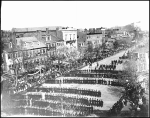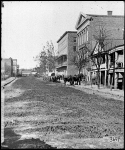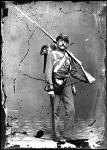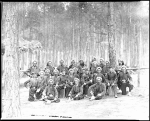|
In a hurry? Save or print these Collection Connections as a single
file.
Go directly to the collection, Selected
Civil War Photographs, in American Memory, or view a Summary
of Resources related to the collection.
 Washington, D.C., President Lincoln's funeral procession on Pennsylvania Avenue
[1865 April 19] |
1) Chronological ThinkingStudents can use the photograph collection as a springboard for learning about causes and results of the Civil War. Pictures of events surrounding Lincoln's assassination can lead students to study circumstances and effects of the assassination. Using photographs showing the fate of conspirators in Lincoln's assassination, students can compare the Civil War justice system with crime and punishment today. Search on assassination, conspirator, funeral,and Lincoln. |
 Atlanta, Ga., View on Decatur Street, showing Trout House and Masonic Hall
[1864] | 2) Historical ComprehensionMany photographs in the collection document contemporary lifestyle of the 1860s, in connection with the War and in general. Students can study structures in cities and small towns. For example, students can review photographs of Atlanta during Sherman's occupation. Students can compare building sizes, styles, and types in Civil War Atlanta to buildings in present day Atlanta. Search on names of cities and towns, such as Atlanta. |
 Unknown location. Unidentified Union volunteer with shouldered rifle and bayonet in
photographer's studio.
[Between 1860 and 1865] | 3) Historical Analysis and InterpretationUsing this collection, students can begin to understand that photographers bring a point of view to their photographs. For example, the collection contains more photographs of Union (Federal) soldiers than Confederate. Students might be asked to: Search on the words Union and Federal (404 hits) and Confederate (107 hits), and then make a hypothesis about why there are more pictures of Northern personnel and activities. Students might then use other sources to confirm or refute their hypotheses. |
 Petersburg, Va., Group of Company G, 114th Pennsylvania Infantry (Zouaves)
[1864 August] | 4) Historical Research CapabilitiesStudents can use the collection as a basis for research. For example, students might formulate a hypothesis to explain differences in style of dress and grooming among soldiers and armies. They might examine differences in uniforms between officers and enlisted men, and among different brigades. For example, the Zouaves of the 114th Pennsylvania Infantry have uniforms that imitate the French infantry in Algeria. Students also may discover that some African American troops wear uniforms, but others with the Federal army do not. Using other sources, students can research reasons for differences in dress, and compare Civil War army dress to U.S. military dress codes today. Search on soldiers, infantry, officer, company, and the names of specific army companies, such as Zouaves. |
 Yorktown, Va., Confederate fortifications reinforced with bales of cotton
[1862 June] | 5) Historical Issue Analysis and Decision MakingStudents can use the photographs to study how people of the 1860s solved problems using the resources at hand. The photographs document peacetime and wartime technology. Students also can explore security measures of the time. They might find examples of breastworks built to fortify positions, blockhouses built to provide secure firing positions, signal towers, hot air balloons, and forts reinforced with gabions (wickerwork cylinders filled with earth) or even bales of cotton. Students can compare Civil War fortifications with those available today. Search on balloon, bridge, breastworks, building, carriage, fortification, photographer, tent, tower, and wagon. |
|



